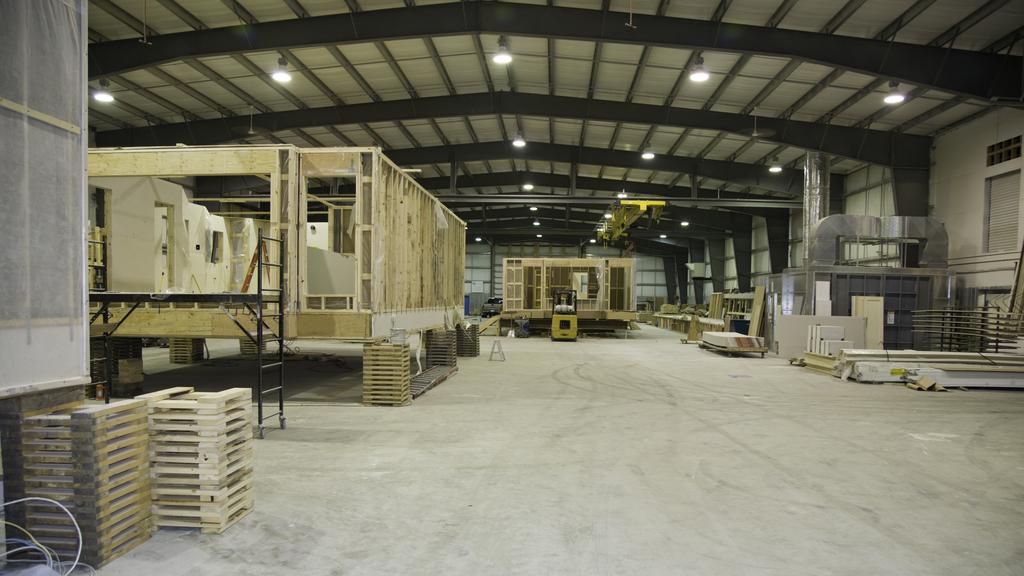Homes crisis answer requires a factory mentality

Modular homes being manufactured in a factory.
By now all states, all major parties, and the public have realised how bad the housing crisis has gotten. The overarching goal now is to ensure adequate access to housing. Most stakeholders agree that adding more housing stock takes priority.
Australia roughly agrees on the goal. Better yet, investors are happy to throw money at the Australian housing market.
Recent policies encouraging more built-to-rent properties are aimed at institutional investors. These are players that can only bankroll sizeable projects – a super fund won’t finance the two townhouses squeezed on your neighbour’s block but might build a tower in suburbia.
Unfortunately, instead of seeing record high building approvals, we’ve been seeing a dry pipeline of new developments. The states now pressure local governments to add more housing stock, serious planning reforms are discussed, and institutional investors have cash earmarked for property. Why aren’t we building like crazy?
To a large degree we don’t have enough workers to build the new homes we so desperately need. There are three reasons for this shortfall.
A few months into the pandemic, the federal government made it very clear that no financial assistance was going to be extended to temporary visa holders. These people heard the government loud and clear and returned to their home countries. This outflow created a hole of a few hundred thousand people in our national workforce of about 14 million people.
By now migration to Australia (calculated as a four-year average) is almost back to pre-pandemic levels, so why is it still so hard to find workers?
To a degree the states are to blame for this. After neglecting infrastructure spending for the past two decades, all states announced large projects at the same time. Most proposed projects are much needed and well overdue. Unfortunately, these projects draw on the same workforce as the residential construction sector.
Infrastructure projects are big, financially lucrative, and provide a stable and juicy income stream for contractors. Plus, government clients are more forgiving with costs blowout (rising material costs, longer duration) than private market clients.
If you do what I do on a Saturday night and download all current state and federal budgets, and scroll to the infrastructure sections, you will laugh hysterically. Just by eyeballing the pipeline of infrastructure projects you realise that we can’t possibly build all these nice things. We just don’t have enough workers to do so.
A bit of centralised co-ordination between the states might’ve helped to minimise the damage but that’s not how the system works. Instead, we have states competing for workers to build their infrastructure and we have the residential construction sector competing with the states for talent.
That’s not the worst news though. Basic demographics go a long way in explaining the ongoing construction skills shortage.
The skills shortage is simply baked into the demographic pie. Over the coming decade, the large Baby Boomer generation (born 1946-63) retires while the smaller Gen Z cohort (born 2000-17) enters the world of work on the other end. Big cohort out, smaller cohort in – that imbalance is a problem. It gets worse once we consider Millennials (born 1982-99). After procrastinating for many years, Millennials are finally making babies at scale. That means they go on parental leave and leave their jobs behind, at least temporarily.
As Boomers continue to retire for a decade and Millennials make babies for another 14 years or so, the skills shortage won’t improve much.
Even our current high migration intake won’t save us because we have so many workers nearing a steep retirement cliff in the coming decade. The concept is simple. A certain share of workers is already of retirement age (nationwide 5 per cent of workers are aged 65+) or will be of retirement age by 2034 (meaning they are 55-64). About 15 per cent of all workers fall into this category.
These workers, totalling about 20 per cent of the workforce, will fall off the retirement cliff throughout the coming decade and will need to be replaced.
Construction as an industry is a bit younger than the national average (4 per cent over 65 and 14 per cent aged 55-64) but some jobs within the industry face an incredibly steep retirement cliff.
Various engineering professions are needed in construction and none of them have a significant share of workers in the 55-plus cohort. While there might be a general shortage of these jobs, there is no retirement wave looming in the coming decade to make things worse.
A similarly optimistic picture emerges when looking at the three most common jobs in construction. Carpenters, electricians, and plumbers all have about 3 per cent of workers aged 65+ and 8-9 per cent aged 55 to 64. The difference to engineering jobs here is of course the physical toll. An engineer can easily work into their 70s if they choose to do so, whereas work on the tools becomes harder each year. The low rate of carpenters and co in the 55+ segment might be linked to relatively early retirement.
All jobs that could be classified as machine operators (crane operating, earthmoving, truck driving) have very high shares of workers marching towards the retirement cliff. As a housing developer I would be extremely nervous about how I might fill these jobs in 10 years. I am certain that the relevant TAFE degrees will be universally free very soon.
A skills shortage in such vital roles presents a strategic risk to our country as it stops us from adding more housing stock and keeps prices at a dangerously unaffordable level.
Property investors, mum and dad type landlords in particular, will be concerned about the 45 per cent of handypersons in the 55+ category. Who will fix all these small problems occurring in your property? Costs for routine repairs will certainly go up in price. The property investor of 2034 had better be prepared to fix little problems themselves. That in turn makes interstate investments less attractive.
With the prolonged skills shortage in mind, it might also be time to build housing differently.
Housing doesn’t need to sit in the construction category; it could be moved to the manufacturing category.
If broken down into its components, a house is nothing but a concrete slab, a few walls, and a roof. These elements could be built in a factory and would only need to be “Lego-ed” into place on site. Weather related delays would also be a thing of the past. In a factory setting we use our limited number of skilled workers better. Tradies drive to the factory in the morning and spend the day on the tools. No more driving from site to site, wasting time in their utes.
In a factory, sizeable machines allow workers to work faster, to increase their output. The job becomes less lonesome, as you have colleagues you work with daily.
The embarrassingly high percentage of material wastage on site could be reduced, too.
Under close supervision, this setting might well allow lower skilled workers to be included in the housing manufacturing process which would keep the labour costs of a project down. Production speed should also increase, and step-by-step quality control would ensure higher quality homes.
These homes would by no means all look the same. Each wall or roof panel can be individualised using the materials available.
Around the world, companies are starting to experiment with mobile housing factories to keep down the transport costs. On a greenfield site you would first pop up a mobile factory and then churn out hundreds of homes locally.
Somebody of course needs to bankroll this truly disruptive approach to building housing. Considering the scale of our housing shortage, the prolonged skills shortage, continued high migration intake, and global demand for more housing, investing heavily into housing factories seems like a worthwhile gamble.
As always, I am looking at super funds, potentially in conjunction with big property developers, to make this transformation happen.
In light of the prolonged skills shortage the current way of building housing is simply too labour intensive.
Simon Kuestenmacher is co-founder and director of research at The Demographics Group







